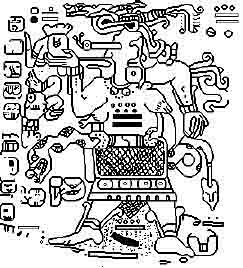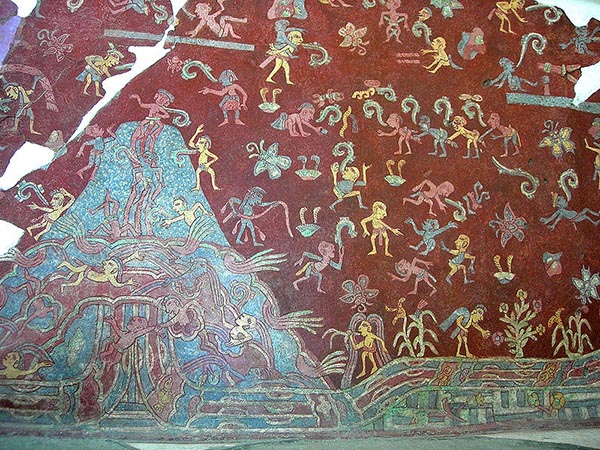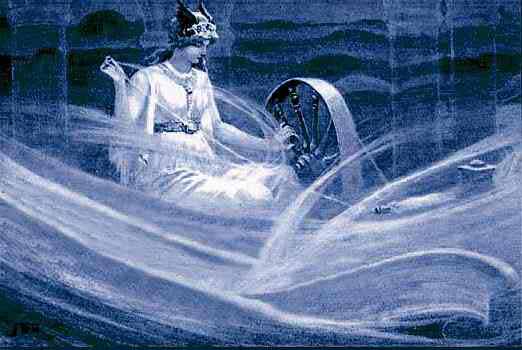

The Teotihuacan Spider Woman was a goddess of the Pre-Columbian Teotihuacan civilization, Maya, in what is now Mexico. In 1942, an interesting discovery was made when a series of murals was found in the Tepantitla compound in Teotihuacan. While many of these murals simply depicted scenes of everyday life in ancient Teotihuacan and some simple Mesoamerican figures, a few contained paintings of a previously-unknown deity.
To this day, no one has found any evidence of her name. Although often referred to as the "great goddess", Karl Taube is the first to appropriately christen her the "Teotihuacan Spider Woman" in his article in the 1983 edition of The Journal of Latin American Lore.
The Tepantitla compound was a kind of apartment complex for what appears to be some very high status citizens. The walls are adorned with brightly painted frescoes fit for royalty. There are two nearly identical murals at this site, separated by a doorway, that illustrate the Spider Woman.
In them, she stands with outstretched arms between two smaller female attendants and in front of two tall, interwoven vines filled with both spiders and butterflies. At her base is a mirror bowl spilling what appears to be a mixture of water and seeds. These murals were painted in beautiful, vibrant colors and have been relatively well preserved.
Due to the highly stylized quality of Mesoamerican art and often to its poor preservation, it can be difficult to determine the gender of a painted or sculpted figure. Also, the ancient people of these areas wore heavily layered clothing that often added to the confusion. This being the case, archaeologist Alfonso Caso mistakenly identified the central figure in the Tepantitla murals as Tlaloc, the Mesoamerican god of rain and warfare.
Several decades passed before this mistake was caught. Further examination eventually revealed that the wardrobe worn by the two female attendants was also visible on the main figure. This belated discovery finally established the Spider WomanÕs femininity.The Teotihuacan Spider Woman has since been found at several other sites, sometimes in murals, and sometimes in sculpture or figure form.
Her most obvious trait is simply the fact that she is female, but she does have several other recognizable qualities to help archaeologists identify her.
The great goddess wears a frame headdress that often includes the face of a jaguar and has a medallion in the center on which an owl is usually depicted.
She will also be shown among several spiders and is frequently seen with a yellow body coloration, further distinguishing her from other Mesoamerican deities.
Her single most recognizable feature, however, is a very distinguishable nosepiece. This bar is large enough to conceal her whole mouth, and is equipped with what appears to be arachnid-like fangs. The rectangle-shaped bar hangs from directly under her nose and usually has three circles on it. Immediately below these circles hang three fangs. The two outer fangs curl to point away from the center, while the middle fang just comes straight down looking like the letter U. The overall affect, then, is an otherwise plain Mesoamerican goddess with a frighteningly spider-like appearance.
This Spider Woman is now thought to have been a goddess of the underworld, darkness, the earth, water, war, and possibly even creation itself. To the ancient civilizations of Mesoamerica, the jaguar, the owl, and especially the spider were considered creatures of darkness, often found in caves and during the night. The fact that the Teotihuacan Spider Woman is frequently depicted with all of these creatures further supports the idea of her underworld connections.
The "great goddess" is connected to darkness and caves, water, and war. One reason to accept these associations is simply because of the jaguar commonly found in her headdress. The jaguar was arguably the most important animal to the Mesoamericans when it came to mythology. The fact, then, that the Spider Woman was associated with the jaguar suggests her greatness. The largest species of cat in the new world, the jaguar can be active at any time during the day, but is most often seen on the prowl at night, and especially at dusk or dawn. It is no wonder, then, that these ancient people related the big cats to darkness, for they are truly the rulers of the night.
Jaguars are also surprisingly good swimmers and are often found near ponds and small lakes, providing the idea that the 'great goddess' is also related to water.
It was also very common amongst the ancient Mesoamericans to associate jaguars with warfare. This is probably the most obvious symbolism suggested for the big cats, provided their predatory nature, mighty jaws, powerful musculature, and huge claws.
The other animal commonly seen in the goddess's headdress is the owl, providing another reason the Spider Woman is thought to have been a goddess of darkness. The owl is one of the most recognizable nocturnal creatures, and was believed to be a messenger for the lords of the underworld. Burrowing owls were also common in the area, living in old prairie dog burrows and other holes in the ground, further suggesting their relationship to caves and the underworld. In numerous cultures throughout the world, the owl is a symbol of darkness, evil, sorcery, and death, but also revered as magical and wise.
To also have been associated with this bird of the night, the Teotihuacan Spider Woman must have indeed been related to the underworld.The great goddess is mostly recognized because of her unusual relationship with spiders. In many murals, the Spider Woman is shown with many of the scurrying arachnids in the background, on her clothing, or hanging from her arms. She is often seen with shields decorated with spider webs, further suggesting her relationship with warfare. Then, of course, is the remarkable nosepiece for which the Teotihuacan Spider Woman is most known. This nosepiece is the single most recognizable adornment of the deity, finalizing her transformation into the arachnid-like goddess.

Interestingly enough, the Spider Woman is not exclusively found in Mesoamerica. Some American Indians in what is now the United States, such as the Pueblo and Navajo worshiped a very similar deity. Referred to as the Spider Grandmother, she shares many traits with the Teotihuacan Spider Woman. Although the idea of this deity originating in Mesoamerica is highly accepted, no one is really sure which culture she initially came from, or how exactly she was passed from one to the other.

Teotihuacan Spider Woman

The Great Goddess of Teotihuacan (or Teotihuacan Spider Woman) is a proposed goddess of the pre-Columbian Teotihuacan civilization (ca. 100 BCE - 700 CE), in what is now Mexico. She is perhaps the veneration of the Virgin of Guadalupe, a creation figure. The Great Goddess wears a frame headdress that includes the face of a
"green bird", generally identified as an owl or "quetzal", and a rectangular nosepiece adorned with three circles below which hang three or five fangs. The outer fangs curl away from the center, while the middle fang points down.

Portion of the actual mural from the Tepantitla compound which appears under the Great Goddess portrait -- the mural is laced with iconography from other creation myths - Annunaki, Egypt, Native America Spider Woman, Ancient Alien Theory, etc.
Spider Woman spins her web, forever creating and connecting everything as if String Theory - (String Theory Brian Greene - go to 14:14) -- vibrating and pulsating but always connected.
The Web is a metaphor for the Internet.
Spider Woman has spun her tales and created the illusion.

Goddesses Who Weave and Spin Creation